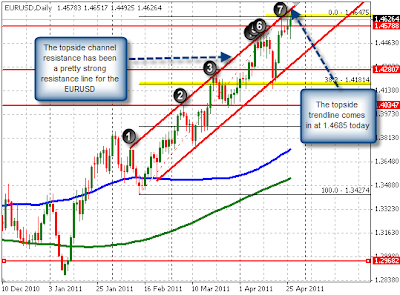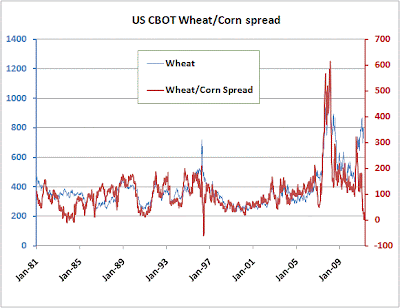Commodities generally performed well last week as supported by weakness in the US dollar. Crude oil, shrugging of warnings that high oil prices would dampen global economic growth, soared with the front-month WTI and Brent contracts gaining +1.46% and +1.53% respectively. Nymex gas remained quiet earlier in the week but rallied after DOE/EIA's report showing smaller-than-expected increase in storage. ICE gas prices also rebounded later in the week, snapping a 2-day selloff, as the demand/supply outlook is expected to tighten. Precious metals under our coverage climbed across the board. Gold remained strong and continued making new highs after breaking above 1500. Silver outperformed gold for another week with prices approaching 50. Base metals were the underperformer during the week with the LME metal index losing -2.57%. Macroeconomic concerns remained the major factor weighing on prices.
Being a major event last week, the April FOMC meeting delivered a tone that was modestly more dovish than what had been expected. Policymakers revised lower GDP growth forecasts but raised inflation outlook. Concerning QE2, the Fed 'will complete purchases of $600B of longer-term Treasury securities by the end of the current quarter'. However, the Fed will continue to reinvest maturing securities, both Treasuries and MBS, in order to hold its balance sheet steady after completing the purchases. The aim of doing so is to prevent passive tightening. At the accompanying statement, the reference that exceptionally low levels of interest rates are warranted for an extended period was retained. Chairman Bernanke noted a rate hike will be seen in 2-3 months' time after such language is eventually removed. Our economists expect to see no change in Fed funds rate at least until 1Q12.
USD slumped as the Fed pledged to leave the monetary stance accommodative. The US dollar index, losing -1.43% during the week, fell to as low as 72.83, a level not seen since July 2008, on Friday. Fed's pledge sent USD lower and bolstered commodities, especially gold and silver. Intensified worries over rising inflationary pressures should continue to support the metals.
We will have 3 major central bank meetings in the coming week. The RBA will leave the cash rate unchanged at 4.75%. However, rising inflation is expected to trigger policymakers to resume tightening in the second half of the year. In Europe, both the ECB and the BOE are facing heightened inflationary pressures. After hiking the main refinancing rate by +25 bps in April, we expect the ECB to stand on the sideline in May. Yet, comments from President Trichet are crucial for future monetary outlook. The BOE will once again leave the Bank rate unchanged at 0.5% and the asset-purchase program at 200B pound. While inflation has kept overshooting target, the majority viewed it as temporary. More importantly, most worried that tightening measures would cripple recovery. Divergent opinions among members are expected, though.
Crude Oil
Weakness in USD sent oil prices higher. The front-month contract for WTI crude oil soared to a new 31-month high of 114.18 on Friday before settling at 113.93. The benchmark began its recent uptrend in last September, marking the longest winning streak on record. The DOE/EIA reported a much bigger –than-expected crude stock-build of +6.16 mmb (consensus: +1.60 mmb) in the week ended April 22. The disappointment was quickly overshadowed by draws in gasoline and distillate stockpiles. We were also impressed by the -0.74 mmd decline in Cushing stock. This second consecutive weekly draw supports our view that Cushing stock has begun reversing the stock-builds previous stock-builds as flows from Canada normalize and Midwest refinery margins improve.
Natural Gas
US gas storage increased +31 bcf to 1685 bcf in the week ended April 22. Despite a third consecutive weekly injection, the size was smaller than expected and thus boosted sentiment. Stocks were now -215 bcf below the same period last year and -11 bcf, or -0.6%, lower than the 5-year average of 1696 bcf. Investors were also thrilled as gas inventory fell below the 5-year average for the first time since the week ended February 25. Separately, Baker Hughes reported the number of gas rigs fell for the first time in 4 weeks, by -4 units to 882 units in the week ended April 29.
Precious Metals
Weakness in USD particularly supported the rally in gold and silver. We believe the metals' strength after the FOMC meeting was in part due to heightened inflation expectations. Indeed, while gold's movement is affected by inflation and inflation expectations, it's also affected by central banks' monetary decisions. Fed's pledge to leave monetary policies accommodative intensified inflation expectations in the US. Elsewhere, Eurozone's CPI jumped +2.8% q/q in April. The market forecasts the ECB to leave interest rates unchanged at the May meeting. However, the focus is on the post-meeting press conference as President Trichet might deliver some hawkish comments. In emerging countries, Russia, China and India are accelerating tightening measures to curb inflation. We advise investors to note that tightening outside the US may eventually dampen gold's uptrend. The timing is not in the near- to medium-term, though.
Silver's outperformance over gold has sent the gold/silver ratio below 32, the first time since 1980, on Thursday. The white metal flirted with the psychological level of 50 last week. Recent trading momentum indeed suggests price will eventually reach there. Yet, the risk of correction is at the same time increasing. Ample mine supply remains the weakest link in silver market. Mexico's National Statistics Institute said that silver mine supply climbed +23.4% to 278 K kg due to new mine production and increased production efficiency at existing facilities. World silver mine supply is expected to increase further in 2011, following a +3% y/y rise last year.
Base Metals
The complex fell with the exception of aluminum which climbed +0.82% during the week. In short, the market worried about global economic slowdown which will affect demand for base metals. We believe these worries were overdone and base metal prices should recover once economic data showed improvements in outlook. According to International Copper Study Group (ICSG), preliminary data shows that the refined copper market balance reached a deficit of -20K metric ton in January 2011, compared with a surplus of +86K metric ton the same period last year. In another report released earlier in the April, ICSG forecasts global growth in copper demand to exceed global growth in copper production this year. The annual production deficit is expected increase to 380K metric ton this year, up +52% from 250K metric ton in 2010.




























